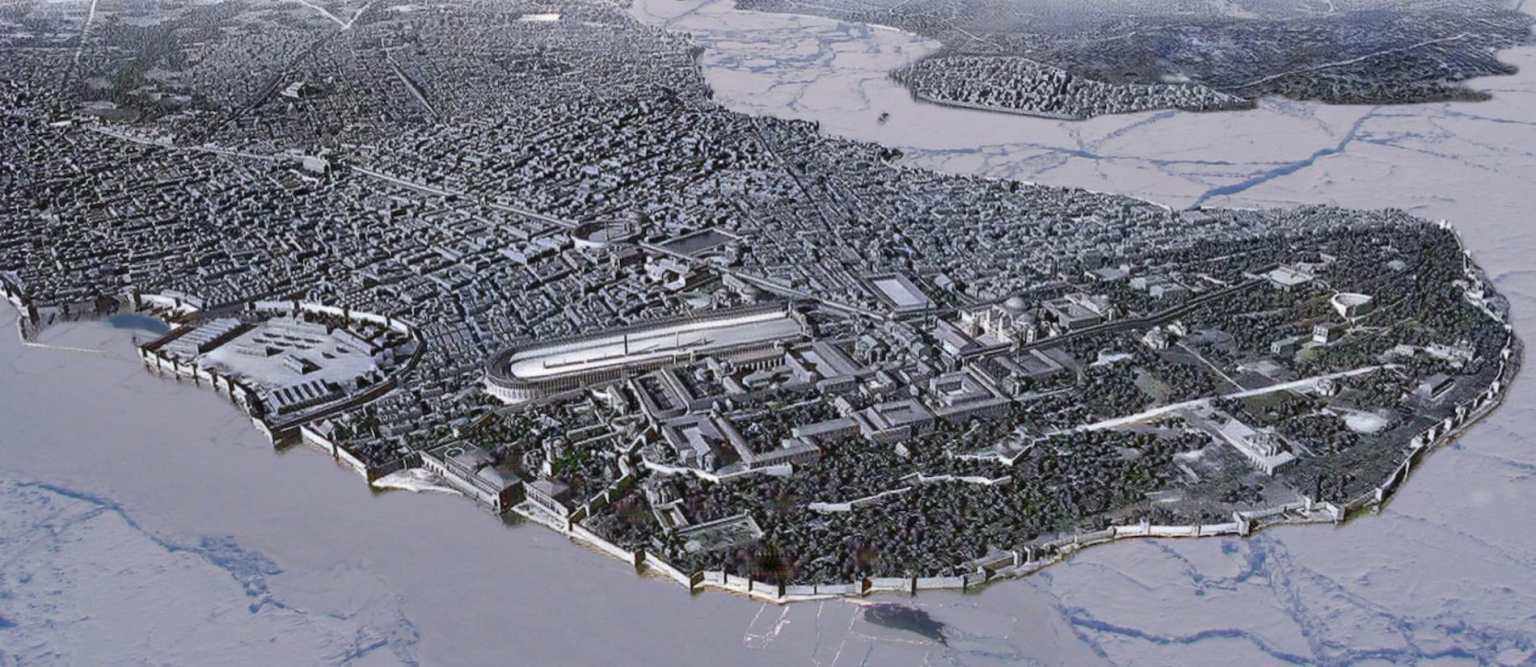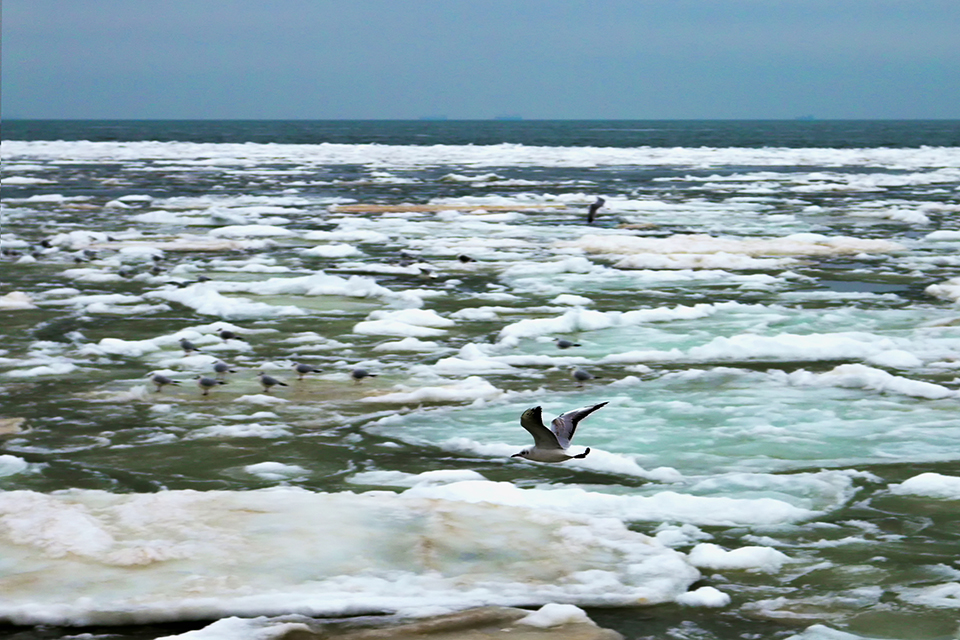In AD 763 volcanic eruptions in Iceland caused icebergs in the Black Sea and a nearly frozen Bosporus causing widespread fear
In the same year, starting in early October, there was very bitterly cold, not only in our land, but even more so to the east, the north, and the west, so that on the north coast of the Pontos to a distance of 1000 miles, the sea froze from cold to a depth of thirty cubits [14 meters]. The same happened from the Zigchia [on the northeast coast of the Black Sea] to the Danube… All this ice was snowed upon and grew by another twenty cubits [9 metres] so that the sea became indistinguishable from land: upon the ice wild men and tame animals could walk from the direction of Chazaria, Bulgaria, and other adjoining countries. In February …this ice was, by God’s command, split up into many different mountain-like sections which were carried down by the force of the winds to Daphnousia and Hieron and, by way of the Straits, reached the city and filled the whole coast as far as Propontis, the Islands and Abydos. Of this, I was myself an eyewitness, for I climbed on one of those [icebergs] and played on it together with some thirty boys of the same age… one of the icebergs struck the jetty of the Acropolis and crushed it. Another huge one struck the wall and shook it greatly so that the houses on the inside partook of the quake. It broke into three pieces and ringed the city from the Magana to the Bosporus rising in height above the walls. All the inhabitants of the City, men, women, and children, ceaselessly watched these things and would return home with lamentation and tears, not knowing what to say. [AD 763-64]
Quoted from: The Chronicle of Theophanes Confessor: Byzantine and Near Eastern History, AD 284– 813, transl. with introduction and commentary by C. Mango, R. Scott, and G. Greatrex. (Clarendon Press, 1997), pp. 600-601
It was one of the coldest winters the region ever experienced. In the year 763, large parts of the Black Sea froze over, and icebergs were spotted on the Boporus. Contemporary historians reported on this unusual weather phenomenon in the winter of 763/764 in their notes from Constantinople, today’s Istanbul. An international, interdisciplinary study by the University of Bern with the participation of the Austrian Academy of Sciences (ÖAW) now shows that this extremely cold period in the early Middle Ages was triggered by volcanic eruptions in Iceland.
Previous estimates of the influence of volcanic eruptions on the global climate between 700 and 1000 AD assumed a volcanic quiescent period. An assumption that, however, contradicts the geological findings from Iceland and sulfate concentrations in ice cores in Greenland, which researchers have now published in the journal ”Communications Earth and Environment” (Nature).

Sulfur Clouds were moving over Europe
The new study analyses the so-called cryptotephra (traces of volcanic ash not visible to the naked eye), high-resolution sulfur isotope, and other chemical indicators of volcanic eruptions from numerous ice cores from Greenland to determine volcanic activity and the concentration of climate-changing sulfur aerosols in the period from 700 to 1000 AD
The research has shown how a longer episode of volcanic sulfur dioxide emissions between 751 and 940 AD was mainly dominated by eruptions in Iceland. “Often, volcanic eruptions have been interpreted as short-lived, random climate forcing, effective for a maximum of one to three years,” explains Imogen Gabriel and Michael Sigl, the lead authors of the study from the University of Bern. However, the new research shows how a series of volcanic eruptions can trigger long-term spells of cold weather (as they presumably did in the period between AD536-41, where the multiple eruptions created a cascade effect).
The early medieval series of eruptions is referred to in the study as the “Icelandic Active Period.” It began with eruptions from the Katla volcano between 751 and 763, some of which reached into the stratosphere and coincided with strong winter cooling anomalies across Europe. These cold periods can be reconstructed based on isotope data from stalactite caves (such as the Spannagel Cave in the Zillertal Alps) as well as historical sources from Ireland to the Mediterranean.
God’s Punishment
The Byzantium researcher Johannes Preiser-Kapeller from the Institute for Medieval Research at the ÖAW, who is involved in the study, explains how these historical climate changes affected early medieval society: “The historical sources not only describe that it was very cold, but that the extreme temperatures caused animals die and crops to freeze. However, people not only suffered immediate hardship but were also deeply shocked on various levels,” reports the OeAW researcher.
When a meteor shower – an impressive astronomical phenomenon that lights up the sky – occurred in March 764, many people projected the preceding hardships and thought the end of the world had come. This time of crisis also had an impact on the political weather. For the then Byzantine Empire, which Preiser-Kapeller is researching, it was a time of internal conflicts that went down in history as the “image dispute”.
Preiser-Kapeller explains how “People argued about how to properly worship the divine. From the perspective of an image worshiper, the emperor was to blame because he forbade the saints to be properly venerated. The crisis was therefore exploited politically and interpreted as a punishment from God.”
The study’s interdisciplinary approach also illustrates the significant contribution of persistent volcanic sulfate emissions to pre-industrial atmospheric aerosol pollution. These emissions have not been sufficiently taken into account in previous climate reconstruction estimates. This underscores the need for further interdisciplinary research to better understand past and present climate feedback associated with these phenomena.
SOURCE:
Press release: Klimaveränderung im Frühmittelalter durch Vulanausbrüche auf Island
READ:
Decadal-to-centennial increases of volcanic aerosols from Iceland challenge the concept of a Medieval Quiet Period
By Imogen Gabriel, Gill Plunkett, Peter Abbott, Melanie Behrens, Andrea Burke, Nathan Chellman, Eliza Cook, Dominik Fleitmann, Maria Hörhold, William Hutchison, Joseph McConnell, Bergrún Óladóttir, Johannes Preiser-Kapeller, Jakub Sliwinski, Patrick Sugden, Birthe Twarloh, and Michael Sigl,
In: Communications Earth & Environment volume 5, Article number: 194 (2024)
ABSTRACT:
Existing global volcanic radiative aerosol forcing estimates portray the period 700 to 1000 as volcanically quiescent, void of major volcanic eruptions. However, this disagrees with proximal Icelandic geological records and regional Greenland ice-core records of sulfate. Here, we use cryptotephra analyses, high-resolution sulfur isotope analyses, and glaciochemical volcanic tracers on an array of Greenland ice cores to characterise volcanic activity and climatically important sulfuric aerosols across the period 700 to 1000. We identify a prolonged episode of volcanic sulfur dioxide emissions (751–940) dominated by Icelandic volcanism, that we term the Icelandic Active Period. This period commences with the Hrafnkatla episode (751–763), which coincided with strong winter cooling anomalies across Europe. This study reveals an important contribution of prolonged volcanic sulfate emissions to the pre-industrial atmospheric aerosol burden, currently not considered in existing forcing estimates, and highlights the need for further research to disentangle their associated climate feedbacks.
READ ALSO:
Around the frozen Lake of Bznunik. Climatic and environmental aspects of the Arab rule in Armenia, 7th-9th century.
Presentation for the Online-Workshop “Armenian Society under Caliphal Rule”, 7–8 December 2023, University of Hamburg (organised by Alasdair Grant)
By Johannes Preiser-Kapeller 2023
